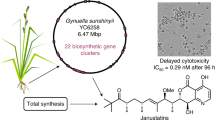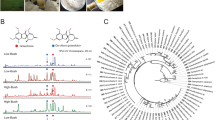Abstract
A series of thielavins I, V, and Q (1–3) and the previously undescribed thielavin Z8 (4) were isolated from cultures of a fungal Shiraia-like sp. (strain MSX60519) that were grown under a suite of media and light conditions, with enhanced biosynthesis noted using rice as a substrate with 12:12 h light:dark cycles. Conversely, oatmeal medium and continuous white light-emitting diode light exposure negatively affected the production of these compounds, at least by strain MSX60519. The structure of 4 was determined using NMR spectroscopic data and mass fragmentation patterns. Of note, the utility of LR-HSQMBC and NOESY NMR experiments in the structural elucidation of these hydrogen-deficient natural products was demonstrated. Compounds 1–4 exhibited cytotoxic activity at the micromolar level against human breast, ovarian, and melanoma cancer cell lines.
This is a preview of subscription content, access via your institution
Access options
Subscribe to this journal
Receive 12 print issues and online access
$259.00 per year
only $21.58 per issue
Buy this article
- Purchase on Springer Link
- Instant access to full article PDF
Prices may be subject to local taxes which are calculated during checkout





Similar content being viewed by others
Data availability
1H NMR, 13C NMR and (+)-HRESIMS data for compounds 1–4. 2D NMR data (HSQC and HMBC) for the new compound (4). MS fragmentation patterns of 1–4. LR-HSQMBC NMR for 1 & 4 and NOESY NMR for 3 & 4. The 1D and 2D NMR spectra for 1–4 were deposited in Harvard Dataverse and can be freely accessed through https://doi.org/10.7910/DVN/QF3WOJ.
References
Al Subeh ZY, et al. Enhanced production and anticancer roperties of photoactivated perylenequinones. J Nat Prod. 2020;83:2490–500.
Al Subeh ZY, et al. Correction to enhanced production and anticancer properties of photoactivated perylenequinones. J Nat Prod. 2020; https://doi.org/10.1021/acs.jnatprod.0c01289.
de Medeiros LS, Murgu M, deSouza AQL, Rodrigues-Fo E. Antimicrobial depsides produced by Cladosporium uredinicola, an endophytic fungus isolated from Psidium guajava fruits. Helv Chim Acta. 2011;94:1077–84.
Take Y, Inouye Y, Nakamura S, Allaudeen HS, Kubo A. Comparative studies of the inhibitory properties of antibiotics on human immunodeficiency virus and avian myeloblastosis virus reverse transcriptases and cellular DNA polymerases. J Antibiot. 1989;42:107–15.
Sakemi S, et al. Thielavins as glucose-6-phosphatase (G6Pase) inhibitors: producing strain, fermentation, isolation, structural elucidation and biological activities. J Antibiot. 2002;55:941–51.
Rivera-Chávez J, González-Andrade M, del Carmen González M, Glenn AE, Mata R. Thielavins A, J and K: α-glucosidase inhibitors from MEXU 27095, an endophytic fungus from Hintonia latiflora. Planta Med. 2013;79:198–205.
Han Z, et al. Thielavins W-Z7, new antifouling thielavins from the marine-derived fungus Thielavia sp. UST030930-004. Mar Drugs. 2017;15:128.
Ayers S, et al. Thielavin B methyl ester: a cytotoxic benzoate trimer from an unidentified fungus (MSX 55526) from the Order Sordariales. Tetrahedron Lett. 2011;52:5733–5.
Kinghorn AD, et al. Discovery of anticancer agents of diverse natural origin. Anticancer Res. 2016;36:5623–37.
Togashi K, Ko HR, Ahn JS, Osada H. Inhibition of telomerase activity by fungus metabolites, CRM646-A and thielavin B. Biosci Biotechnol Biochem. 2001;65:651–3.
Rojas IS, Lotina-Hennsen B, Mata R. Effect of lichen metabolites on thylakoid electron transport and photophosphorylation in isolated spinach chloroplasts. J Nat Prod. 2000;63:1396–9.
Kitahara N, Endo A, Furuya K, Takahashi S. Thielavin A and B, new inhibitors of prostaglandin biosynthesis produced by Thielavia terricola. J Antibiot. 1981;34:1562–8.
Kitahara N, Haruyama H, Hata T, Takahashi S. The structures of thielavins A, B and C. Prostaglandin synthetase inhibitors from fungi. J Antibiot. 1983;36:599–600.
Jang J-P, et al. Inhibition of indoleamine 2,3-dioxygenase by thielavin derivatives from a soil fungus, Coniochaeta sp. 10F058. J Antibiot. 2014;67:331–3.
Matsumoto K, et al. Isolation and biological activity of thielocins: novel phospholipase A2 inhibitors produced by Thielavia terricola RF-143. J Antibiot. 1995;48:106–12.
de Medeiros LS, Murgu M, de-Souza AQ, Rodrigues-Fo E. Erratum: antimicrobial depsides produced by Cladosporium uredinicola, an endophytic fungus isolated from Psidium guajava fruits. Helv Chim Acta. 2013;96:1406–7.
de Medeiros LS, et al. Dereplication-guided isolation of depsides thielavins S-T and lecanorins D-F from the endophytic fungus Setophoma sp. Phytochemistry .2015;111:154–62.
Elyashberg M. Identification and structure elucidation by NMR spectroscopy. Trends Anal Chem. 2015;69:88–97.
Keifer PA. NMR spectroscopy in drug discovery: tools for combinatorial chemistry, natural products, and metabolism research. Prog Drug Res. 2000;55:137.
Du L, King JB, Cichewicz RH. Chlorinated polyketide obtained from a Daldinia sp. treated with the epigenetic modifier suberoylanilide hydroxamic acid. J Nat Prod. 2014;77:2454–8.
Bills GF, Gloer JB. Biologically active secondary metabolites from the fungi. Microbiol Spectr. 2016;4. FUNK-0009-2016. https://www.asmscience.org/content/journal/microbiolspec/10.1128/microbiolspec.FUNK-0009-2016.
Williamson RT, Buevich AV, Martin GE, Parella T. LR-HSQMBC: a sensitive NMR technique to probe very long-range heteronuclear coupling pathways. J Org Chem. 2014;79:3887–94.
Tran TD et al. NMR characterization of rearranged staurosporine aglycone analogues from the marine sponge Damiria sp. Magn Reson Chem. 2019; https://doi.org/10.1002/mrc.4932.
Chan STS, et al. Characterization and synthesis of Eudistidine C, a bioactive marine alkaloid with an intriguing molecular scaffold. J Org Chem. 2016;81:10631–40.
Motiram-Corral K, Nolis P, Parella T, Sauri J. LR-HSQMBC versus LR-selHSQMBC: enhancing the observation of tiny long-range heteronuclear NMR correlations. J Nat Prod. 2020;83:1275–82.
Acknowledgements
This research was supported by the National Institutes of Health via the National Cancer Institute (P01 CA125066). We thank Dr Tamam El-Elimat, Dr Laura Flores-Bocanegra, and Tyler Graf for helpful suggestions.
Author information
Authors and Affiliations
Corresponding author
Ethics declarations
Conflict of interest
NHO declares that he is a member of the Scientific Advisory Board of Mycosynthetix, Inc.
Additional information
Publisher’s note Springer Nature remains neutral with regard to jurisdictional claims in published maps and institutional affiliations.
Supplementary information
Rights and permissions
About this article
Cite this article
Al Subeh, Z.Y., Raja, H.A., Maldonado, A. et al. Thielavins: tuned biosynthesis and LR-HSQMBC for structure elucidation. J Antibiot 74, 300–306 (2021). https://doi.org/10.1038/s41429-021-00405-6
Received:
Revised:
Accepted:
Published:
Issue Date:
DOI: https://doi.org/10.1038/s41429-021-00405-6
This article is cited by
-
Media and strain studies for the scaled production of cis-enone resorcylic acid lactones as feedstocks for semisynthesis
The Journal of Antibiotics (2021)



